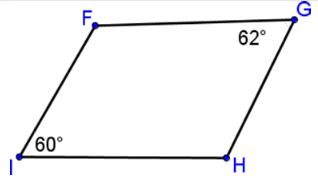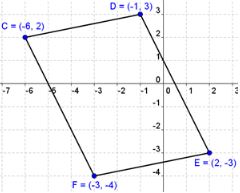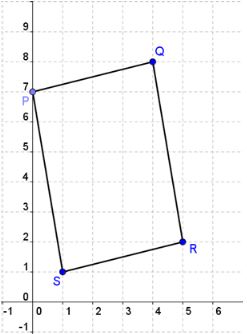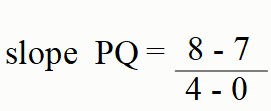Try It
Proving Quadrilaterals are Parallelograms Practice
Practice Problem #1
Is there enough information to prove the quadrilateral is a parallelogram?

Answer: Yes
Which reason explains your answer?
- One pair(s) of opposite sides are parallel and congruent
- Both pairs of opposite sides are parallel
- Both pairs of opposite sides are congruent
- Both pairs of opposite angles are congruent
- Consecutive angles are supplementary
Answer: Both pairs of opposite sides are congruent
Practice Problem #2
Is there enough information to prove the quadrilateral is a parallelogram?

Answer: No
Which reason explains your answer?
- One pair(s) of opposite sides are parallel and congruent
- Opposite sides are not parallel
- Opposite sides are not congruent
- Opposite angles are not congruent
- Consecutive angles are not supplementary
Answer: Opposite angles are not congruent
Practice Problem #3
Show that C(-6, 2), D(-1, 3), E(2, -3), F(-3, -4) are vertices of a parallelogram. Use method 2, which is the slope formula to prove opposite sides are parallel.

Answer:




Practice Problem #4
What kind of quadrilateral is PQRS? Justify your answer. P(0, 7), Q(4, 8), R(5, 2), and S(1, 1).
We start this problem by graphing PQRS on the coordinate plane as show in the image. However, we will not be able to identify PQRS by the graph alone. Next, calculate the slope of all of the sides to see if any are parallel. Always use the first point in the segment as (x1, y1) and the second as (x2, y2) for your calculations.
If the lines are parallel, their slopes are equal.


What is the slope of PQ?


What is the slope of Ps?


slope PS = -6
What is the slope of QR?


slope QR = -6
What is the slope of RS?



slope RS = 4
Now that we have determined the slopes, are any sides parallel? Answer: Yes, There are two sets of parallel sides.
Which side is parallel to PQ? Answer: RS
Which side is parallel to PS? Answer: QR
Are there any sides that are perpendicular to one another? Answer: No, and that allows us to limit the type of quadriliateral further.
Now, we must calculate the length of the sides.

What is the length of PQ?




What is the length of PS?




What is the length of QR?




What is the length of RS?




So we can say that two pairs of sides are congruent. And the anwers to our orignal question, what kind of quadrilateral is PQRS is parallelogram.